Subduction of sedimentary carbonate in the Mariana trench
Affiliations | Corresponding Author | Cite as | Funding information- Share this article





Article views:1,117Cumulative count of HTML views and PDF downloads.
- Download Citation
- Rights & Permissions
top
Abstract
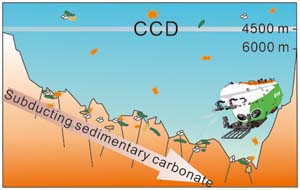
Figures
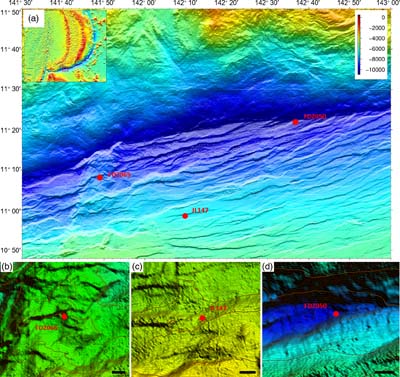 Figure 1 (a) A bathymetric shaded relief map of the study area displaying the location of the discovered carbonate sediments (red dots) on the incoming Pacific plate of the Mariana Trench. The map was constructed using multi-beam data obtained during several visits to the area by the R/V Tansuoyihao. (b–d) Enlarged bathymetric maps show that the sites of carbonate sediments are closely associated with bending-related fault zones. | 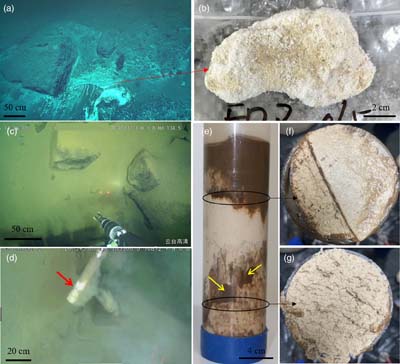 Figure 2 Carbonate sediments in the Challenger Deep of the MT. (a) Outcrop of carbonate deposits at site FDZ065. (b) Carbonate specimen from site FDZ065. (c) Topographic feature showing the discovery of carbonate deposits at site FDZ050. (d) White materials marked by red arrow are carbonate sediments at site FDZ050. (e) Push-core sediments from site FDZ050. Note: the presence of deep sea clay around the lower part (indicated by yellow arrows) is a result of sampling artifacts that occurred during the insertion of the push-core. This is verified by the cross section of the push-core (f and g). The inner of the push-core is pure white without clay (f and g). Only the core samples were used for analysis in this study. |  Figure 3 Photomicrographs of carbonate sediments from the studied samples. (a) Buccinosphaera invaginata, First Appearance Datum (FAD): 0.34 Ma, 2 cm depth at site FDZ050. (b) Paragloborotalia siakensis, age: lower Oligocene–upper Miocene, 8 cm depth at FDZ050. (c) Cyclicargolithus floridanus. age: Paleogene 11.85 Ma, 8 cm depth at FDZ050. (d) Discoaster exilis, age: 17.39–10.49 Ma, 8 cm of FDZ050. (e) Calocycletta mizutamiensis, age: early mid-Miocene, 8 cm depth at FDZ050. (f) Calocycletta costata, age: 17.6–13.44 Ma, 21 cm depth at FDZ050. (g) Planktonic foraminifera Globoturborotalita euapertura, age: Oligocene–early Miocene, FDZ065. (h) Planktonic foraminifera Dentoglobigerina globularis, age: Oligocene–early Miocene, FDZ065. | 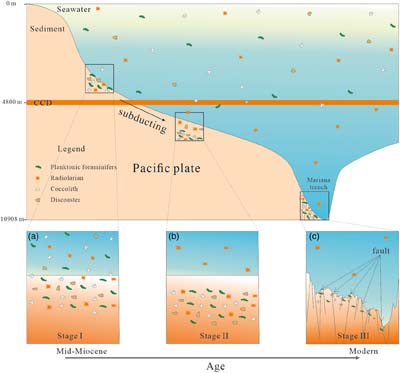 Figure 4 Conceptual diagram depicting the potential genesis of carbonate sediments in the Challenger Deep of the MT. (a) Stage I: carbonate was rapidly deposited and buried in the seafloor above the CCD during the mid-Miocene. (b) Stage II: the Pacific plate subduction carried these carbonate sediments from the site of sedimentation to the Challenger Deep of the MT. (c) Stage III: carbonate sediments were exposed due to the subducting-related normal faults. |
| Figure 1 | Figure 2 | Figure 3 | Figure 4 |
top
Introduction
Calcite compensation depth (CCD) is a boundary in the ocean where the rate of calcium carbonate supply from the surface is matched by the dissolution. It forms the transition between carbonate-bearing and carbonate-absent zones and is thus linked to the ocean-atmosphere carbon cycling system and global climate (Van Andel, 1975
Van Andel, T.H. (1975) Mesozoic/cenozoic calcite compensation depth and the global distribution of calcareous sediments. Earth and Planetary Science Letters 26, 187–194. https://doi.org/10.1016/0012-821X(75)90086-2
; Rea and Lyle, 2005Rea, D.K., Lyle, M.W. (2005) Paleogene calcite compensation depth in the eastern subtropical Pacific: Answers and questions. Paleoceanography 20. https://doi.org/10.1029/2004PA001064
; Pälike et al., 2012Pälike, H., Lyle, M.W., Nishi, H., Raffi, I., Ridgwell, A., et al. (2012) A Cenozoic record of the equatorial Pacific carbonate compensation depth. Nature 488, 609–614. https://doi.org/10.1038/nature11360
). At present, the CCD varies substantially with latitude and longitude and is estimated to be 4000–5000 m below sea level (mbsl) in the ocean (Sulpis et al., 2018Sulpis, O., Boudreau, B.P., Mucci, A., Jenkins, C., Trossman, D.S., Arbic, B.K., Key, R.M. (2018) Current CaCO3 dissolution at the seafloor caused by anthropogenic CO2. Proceedings of the National Academy of Sciences 115, 11700–11705. https://doi.org/10.1073/pnas.1804250115
). In theory, the sediments below the CCD are essentially carbonate-free residues comprising sediments such as pelagic red clay and diatom ooze (Dutkiewicz and Müller, 2021Dutkiewicz, A., Müller, R.D. (2021) The carbonate compensation depth in the South Atlantic Ocean since the Late Cretaceous. Geology 49, 873–878. https://doi.org/10.1130/G48404.1
).The hadal zone, with depths greater than 6000 m, mostly comprised of deep trenches, and constituting the deepest part of the world’s oceans, represents the least explored habitat. Tectonically, hadal trenches are formed in subduction zones and are thus key hinge points of the material cycling between the Earth’s interior and exosphere (Du et al., 2021
Du, M., Peng, X., Zhang, H., Ye, C., Dasgupta, S., Li, J., Li, J., Liu, S., Xu, H., Chen, C., Jing, H., Xu, H., Liu, J., He, S., He, L., Cai, S., Chen, S., Ta, K. (2021) Geology, environment, and life in the deepest part of the world’s oceans. The Innovation 2, 100109. https://doi.org/10.1016/j.xinn.2021.100109
). Subduction is the primary mechanism for transporting carbon from the surface into the interior of the Earth. Carbonate sediments, comprising up to 50 % of total carbon subduction fluxes, serve as the dominant host for carbon transported into the mantle at subduction zone settings (Plank and Manning, 2019Plank, T., Manning, C.E. (2019) Subducting carbon. Nature 574, 343–352. https://doi.org/10.1038/s41586-019-1643-z
). Nevertheless, carbonate sediment distribution exhibits significant spatial heterogeneity in global subduction zones (Kelemen and Manning, 2015Kelemen, P.B., Manning, C.E. (2015) Reevaluating carbon fluxes in subduction zones, what goes down, mostly comes up. Proceedings of the National Academy of Sciences 112, E3997–E4006. https://doi.org/10.1073/pnas.1507889112
; Clift, 2017Clift, P.D. (2017) A revised budget for Cenozoic sedimentary carbon subduction. Reviews of Geophysics 55, 97–125. https://doi.org/10.1002/2016RG000531
). Traditionally, it was believed that carbonates would be completely absent in hadal sediments due to the corrosive seawater. Previous studies thus proposed that no sedimentary carbon was subducted at hadal subduction zones, such as the Tonga, Central Aleutian, and Kuriles-Kamchatka Trenches (Rea and Ruff, 1996Rea, D.K., Ruff, L.J. (1996) Composition and mass flux of sediment entering the world’s subduction zones: Implications for global sediment budgets, great earthquakes, and volcanism. Earth and Planetary Science Letters 140, 1–12. https://doi.org/10.1016/0012-821X(96)00036-2
; Plank and Langmuir, 1998Plank, T., Langmuir, C.H. (1998) The chemical composition of subducting sediment and its consequences for the crust and mantle. Chemical Geology 145, 325–394. https://doi.org/10.1016/S0009-2541(97)00150-2
; Plank and Manning, 2019Plank, T., Manning, C.E. (2019) Subducting carbon. Nature 574, 343–352. https://doi.org/10.1038/s41586-019-1643-z
).Here we provide the first study of carbonate deposits in the Mariana Trench (MT) from a water depth of 6675–10813 mbsl during an expedition in September 2021 with the manned submersible Fendouzhe (Fig. 1, Table S-1). The occurrence of sedimentary carbonate at hadal depths was unexpected, as it is far deeper than the CCD of this zone at 4800 mbsl. To elucidate this anomaly, we conducted morphological, mineralogical, and geochemical analyses, along with mode calculations, to explore the origin and unusual preservation of those carbonate sediments. Additionally, we established an age model using a combination of microfossil biostratigraphy and strontium/oxygen isotopes of the carbonate sediments.

Figure 1 (a) A bathymetric shaded relief map of the study area displaying the location of the discovered carbonate sediments (red dots) on the incoming Pacific plate of the Mariana Trench. The map was constructed using multi-beam data obtained during several visits to the area by the R/V Tansuoyihao. (b–d) Enlarged bathymetric maps show that the sites of carbonate sediments are closely associated with bending-related fault zones.
top
Results
The push-core from site FDZ050 is divided into two parts (Fig. 2e): the upper 0–3 cm is in situ pelagic brown clay sediments with low concentrations of siliceous radiolarians, and the lower 3–21cm is mainly white biogenic deposits composing of well-preserved calcareous microfossils such as calcareous nannofossils, planktonic foraminifers, and dinoflagellates (Figs. 3, S-2 and S-3). Siliceous radiolarians are very abundant, with tens to hundreds of thousands of individuals per gram in the lower part (Fig. 3). The assemblages and distributions of marine microfossils in the lower part of site FDZ050 are similar to those in the carbonate deposits at sites FDZ065 and JL147 (Fig. 3). Calcareous nannofossils are the most abundant microfossils in these carbonate deposits. The nannofossil assemblage is dominated by Cyclicargolithus floridanus, Discoaster spp, Sphenolithus moriformis, Sphenolithus heteromorphus, and Reticulofenestra spp (Table S-4, Figs. 3, S-2, S-3 and S-4). The carbonate deposits also include many planktonic foraminiferal tests, such as Dentoglobigerina globularis and Globoturborotalita euapertura, indicative of the early Miocene period (Fig. 3g-h). Based on the assemblages of marine microfossils and the presence of index fossils, the original deposit time is assigned to the Miocene between 17.6 and 13.5 Ma (Table S-4). The average 87Sr/86Sr isotope ratio from four samples is 0.708477 (Table S-3). Comparison with the 87Sr/86Sr ratio curves of McArthur et al. (2001)
McArthur, J.M., Howarth, R.J, Bailey, T.R. (2001) Strontium isotope stratigraphy: LOWESS version 3: best fit to the marine Sr-isotope curve for 0–509 Ma and accompanying look-up table for deriving numerical age. The Journal of Geology 109, 155–170. https://doi.org/10.1086/319243
suggests an age of Miocene. Oxygen isotope values of carbonates (Table S-3) also further verify the sedimentary age of the Miocene (Grossman and Joachimski, 2020Grossman, E.L., Joachimski, M.M. (2020) Chapter 10 - Oxygen Isotope Stratigraphy. In: Gradstein, F.M., Ogg, J.G., Schmitz, M.D., Ogg, G.M. (Eds.) Geologic Time Scale 2020. Elsevier, Amsterdam, 279–307. https://doi.org/10.1016/B978-0-12-824360-2.00010-3
), which is consistent with the age suggested by the microfossil biostratigraphy.
Figure 2 Carbonate sediments in the Challenger Deep of the MT. (a) Outcrop of carbonate deposits at site FDZ065. (b) Carbonate specimen from site FDZ065. (c) Topographic feature showing the discovery of carbonate deposits at site FDZ050. (d) White materials marked by red arrow are carbonate sediments at site FDZ050. (e) Push-core sediments from site FDZ050. Note: the presence of deep sea clay around the lower part (indicated by yellow arrows) is a result of sampling artifacts that occurred during the insertion of the push-core. This is verified by the cross section of the push-core (f and g). The inner of the push-core is pure white without clay (f and g). Only the core samples were used for analysis in this study.

Figure 3 Photomicrographs of carbonate sediments from the studied samples. (a) Buccinosphaera invaginata, First Appearance Datum (FAD): 0.34 Ma, 2 cm depth at site FDZ050. (b) Paragloborotalia siakensis, age: lower Oligocene–upper Miocene, 8 cm depth at FDZ050. (c) Cyclicargolithus floridanus. age: Paleogene 11.85 Ma, 8 cm depth at FDZ050. (d) Discoaster exilis, age: 17.39–10.49 Ma, 8 cm of FDZ050. (e) Calocycletta mizutamiensis, age: early mid-Miocene, 8 cm depth at FDZ050. (f) Calocycletta costata, age: 17.6–13.44 Ma, 21 cm depth at FDZ050. (g) Planktonic foraminifera Globoturborotalita euapertura, age: Oligocene–early Miocene, FDZ065. (h) Planktonic foraminifera Dentoglobigerina globularis, age: Oligocene–early Miocene, FDZ065.
XRD measurements and quantitative analysis suggest that the carbonate is calcite (Fig. S-1). Model calculations show that the sedimentary environments in hadal zones are under saturated with calcite and aragonite (Table S-2), indicating that the carbonate sediments can only survive under specific conditions. This result was further verified by the absence of carbonate components in the other cores (Liu and Peng, 2019
Liu, S., Peng, X. (2019) Organic matter diagenesis in hadal setting: Insights from the pore-water geochemistry of the Mariana Trench sediments. Deep-Sea Research Part I-Oceanographic Research Papers 147, 22–31. https://doi.org/10.1016/j.dsr.2019.03.011
). Stable carbon isotope records of bulk sediments at Sites FDZ050 and 065 exhibit similar patterns (Table S-3).top
Discussion
Potential genesis of carbonate deposits. The absence of carbonate components in the upper 0–3 cm from site FDZ050 suggests that continuous carbonate deposition from the surface ocean was insufficient to counteract carbonate dissolution in the hadal environment. Consequently, these carbonate sediments are likely not the result of in situ deposits in the hadal settings.
A limited number of studies have reported the occurrence of carbonate deposits on the seafloor deeper than the modern CCD. For example, calcareous ooze sediments were discovered by the Ocean Discovery Program in the central basin of the South China Sea (Site U1433, 4372 m water depth, CCD at ∼3500 m) (Zhou et al., 2019
Zhou, X., Lyu, X., Liu, C., Liu, Z., Li, Q., Jin, X., Zhang, H., Dadd, K. (2019) Depositional mechanisms for upper Miocene sediments in the South China Sea central basin: Evidence from calcareous nannofossils. Marine Micropaleontology 151, 101768. https://doi.org/10.1016/j.marmicro.2019.101768
), the North Pacific Ocean (Site 1179, 5565 m water depth, CCD at ∼4500 m) (McCarthy et al., 2004McCarthy, F.M., Findlay, D.J., Little, M.L. (2004) The micropaleontological character of anomalous calcareous sediments of late Pliocene through early Pleistocene age below the CCD in the northwestern North Pacific Ocean. Palaeogeography, Palaeoclimatology, Palaeoecology 215, 1–15. https://doi.org/10.1016/j.palaeo.2004.07.032
), and the East Pacific Rise (Site 1215, 5396 m water depth) (Leon-Rodriguez and Dickens, 2010Leon-Rodriguez, L., Dickens, G.R. (2010) Constraints on ocean acidification associated with rapid and massive carbon injections: The early Paleogene record at ocean drilling program site 1215, equatorial Pacific Ocean. Palaeogeography, Palaeoclimatology, Palaeoecology 298, 409–420. https://doi.org/10.1016/j.palaeo.2010.10.029
). Calcareous deposits from sites U1433 and 1215 were interpreted as turbidity currents derived from adjacent carbonate platforms. In contrast, calcium carbonate at site 1179 was considered as a combined result of increased production of calcareous plankton at the sea surface and the rate of sedimentation to the seafloor. Furthermore, Yamamoto et al. (1988)Yamamoto, S., Tokuyama, H., Fujioka, K., Takeuchi, A., Ujiié, H. (1988) Carbonate turbidites deposited on the floor of the Palau Trench. Marine Geology 82, 217–233. https://doi.org/10.1016/0025-3227(88)90142-9
reported carbonate turbiditic deposits at the Palau Trench at 8053 m, while carbonate-rich sediments were also found at the New Britain Trench at 8225 m (Luo et al., 2019Luo, M., Gieskes, J., Chen, L., Scholten, J., Pan, B., Lin, G., Chen, D. (2019) Sources, Degradation, and Transport of Organic Matter in the New Britain Shelf-Trench Continuum, Papua New Guinea. Journal of Geophysical Research-Biogeosciences 124, 1680–1695. https://doi.org/10.1029/2018JG004691
). These deposits were generally attributed to rapid deposition and burial resulting from recent mass wasting events.A prominent feature of the hadal zone is the frequent occurrence of sediment mass wasting events (Zabel et al., 2022
Zabel, M., Glud, R.N., Sanei, H., Elvert, M., Pape, T., Chuang, P.C., Okuma, E., Geprägs, P., Kölling, M. (2022) High Carbon Mineralization Rates in Subseafloor Hadal Sediments—Result of Frequent Mass Wasting. Geochemistry, Geophysics, Geosystems 23, e2022GC010502. https://doi.org/10.1029/2022GC010502
). These events, often triggered by common earthquakes, can rapidly transport material from shallow water into the hadal zone, which could potentially explain the origin of carbonate sediments in this study as frequent slump deposits. However, we exclude mass wasting deposits based on the following evidence: (1) current research indicates that mass wasting events primarily occur on the landward slop (overlying plate) of hadal trenches, such as the Middle America Trench (Ranero and von Huene, 2000Ranero, C.R., von Huene, R. (2000) Subduction erosion along the Middle America convergent margin. Nature 404, 748–752. https://doi.org/10.1038/35008046
) and the Japan Trench (McHugh et al., 2016McHugh, C.M., Kanamatsu, T., Seeber, L., Bopp, R., Cormier, M.-H., Usami, K. (2016) Remobilization of surficial slope sediment triggered by the A.D. 2011 Mw9 Tohoku-Oki earthquake and tsunami along the Japan Trench. Geology 44, 391–394. https://doi.org/10.1130/G37650.1
). The steeper topography of the overlying plate favours sediment transport into the hadal zone through mass wasting events (Ueda et al., 2023Ueda, H., Kitazato, H., Jamieson, A., Bond, T., Cardigos, S., Funaki, M., Maroni, P.J., Nanbu, H., O’Callaghan, J.M., Onishi, T., Pedersen, S.W., Roperez, J., Tsuruzono, H., Watanabe, H.K., Yasuda, T., Pressure Drop Ring of Fire Expedition Japan Cruise Leg2 science team (2023) The submarine fault scarp of the 2011 Tohoku-oki Earthquake in the Japan Trench. Communications Earth & Environment 4, 476. https://doi.org/10.1038/s43247-023-01118-4
). (2) The majority of bending-related normal faults, located in the subducting plate of the hadal trenches (Ranero et al., 2003Ranero, C.R., Morgan, J.P., McIntosh, K., Reichert, C. (2003) Bending-related faulting and mantle serpentinization at the Middle America trench. Nature 425, 367–373. https://doi.org/10.1038/nature01961
; Zhou et al., 2015Zhou, Z., Lin, J., Behn, M.D., Olive, J.-A. (2015) Mechanism for normal faulting in the subducting plate at the Mariana Trench. Geophysical Research Letters 42, 4309–4317. https://doi.org/10.1002/2015GL063917
), give rise to abundant horst structures reaching heights of up to 400 m. These structures impede sediment transport from shallow water to the hadal trench through mass wasting events (Fig. S-5). In contrast, sediments can be transported into the hadal zone on the landward slope via mass wasting events (McHugh et al., 2016McHugh, C.M., Kanamatsu, T., Seeber, L., Bopp, R., Cormier, M.-H., Usami, K. (2016) Remobilization of surficial slope sediment triggered by the A.D. 2011 Mw9 Tohoku-Oki earthquake and tsunami along the Japan Trench. Geology 44, 391–394. https://doi.org/10.1130/G37650.1
). (3) The well preserved morphology of calcareous nannofossils, including intact coccolithophores (Fig. 3), suggests that they were not subjected to harsh transport processes such as debris flow or turbidity. Submarine channels (such as valleys or canyons), necessary for turbidity formation, have not been identified in the Challenger Deep through new high resolution multibeam mappings (Figs. 1, S-5). These carbonate deposits, characterised by abundant calcareous microfossils and a complete absence of mud or clay matrix, clearly result from rapid in situ deposits of calcareous fossils. If these carbonate sediments were transported to the hadal zone by turbidity currents, they would be exposed to corrosive seawater, leading to widespread dissolution. Figure S-4 shows that sedimentary carbonate dissolution occurred at a depth of 4 cm, not 21 cm, further excluding the possibility of turbidity current genesis. In summary, our study convincingly refutes the turbidity genesis hypothesis.Previous studies suggest that the time before burial of calcareous microfossils in sediments below the CCD far exceeds their complete dissolution time (Honjo and Erez, 1978
Honjo, S., Erez, J. (1978) Dissolution rates of calcium carbonate in the deep ocean; an in-situ experiment in the North Atlantic Ocean. Earth and Planetary Science Letters 40, 287–300. https://doi.org/10.1016/0012-821X(78)90099-7
). Additionally, calcareous nannofossils do not show evidence of intense dissolution (Figs. 3, S-4b), suggesting that those carbonates were not exposed in hadal environments for a long period. This implies that the explanation of increased production of calcareous plankton at the sea surface and an increased rate of sedimentation on the seafloor may not apply here.The geomorphic settings of the studied sites share similarities, being located on normal faulting scarps in the subducting plate (Figs. 1, S-5), implying a potential correlation between the outcropping of carbonate sediments and these faults. Bending-related extensional faults extensively traverse the entire trench slope of the subducting Pacific plate in the MT (Zhou et al., 2015
Zhou, Z., Lin, J., Behn, M.D., Olive, J.-A. (2015) Mechanism for normal faulting in the subducting plate at the Mariana Trench. Geophysical Research Letters 42, 4309–4317. https://doi.org/10.1002/2015GL063917
). The development of these extensional bending-related faults favours the exhumation of deeply buried carbonate sediments. The absence of carbonate components in nearby cores located in graben zones (Liu and Peng, 2019Liu, S., Peng, X. (2019) Organic matter diagenesis in hadal setting: Insights from the pore-water geochemistry of the Mariana Trench sediments. Deep-Sea Research Part I-Oceanographic Research Papers 147, 22–31. https://doi.org/10.1016/j.dsr.2019.03.011
) further supports the idea that the exposure of carbonate sediment is related to subducting-related normal faults.In summary, we propose a three stage model as a potential genesis for the carbonate deposits in the MT (Fig. 4): (1) carbonate materials from the surface ocean were rapidly deposited and buried in the seafloor above the CCD during the early–middle Miocene, (2) the subduction of the Pacific plate transported these carbonate sediments from the sedimentation site to the Challenger Deep of the MT, and (3) carbonate sediments were exposed due to the subducting-related normal faults. While another explanation could be the deepening of the CCD in the geological evolution of oceans leading to carbonate deposits in hadal zones, we consider this highly unlikely, as it was improbable that CCD fluctuation exceeded 1 km at the equatorial Pacific since the Miocene (Pälike et al., 2012
Pälike, H., Lyle, M.W., Nishi, H., Raffi, I., Ridgwell, A., et al. (2012) A Cenozoic record of the equatorial Pacific carbonate compensation depth. Nature 488, 609–614. https://doi.org/10.1038/nature11360
).
Figure 4 Conceptual diagram depicting the potential genesis of carbonate sediments in the Challenger Deep of the MT. (a) Stage I: carbonate was rapidly deposited and buried in the seafloor above the CCD during the mid-Miocene. (b) Stage II: the Pacific plate subduction carried these carbonate sediments from the site of sedimentation to the Challenger Deep of the MT. (c) Stage III: carbonate sediments were exposed due to the subducting-related normal faults.
Implications for subducting carbon. Sedimentary carbonates were considered to contribute approximately 80 % of the total subducting carbon sediment flux (Clift, 2017
Clift, P.D. (2017) A revised budget for Cenozoic sedimentary carbon subduction. Reviews of Geophysics 55, 97–125. https://doi.org/10.1002/2016RG000531
). However, they are rare on the seafloor near hadal trenches, such as the Mariana and Tonga trenches, resulting in essentially zero sedimentary carbonate being subducted along these old and cold oceanic plates (Plank and Manning, 2019Plank, T., Manning, C.E. (2019) Subducting carbon. Nature 574, 343–352. https://doi.org/10.1038/s41586-019-1643-z
). The Mariana subduction system, characterised as a non-accretionary convergent plate margin (Haggerty, 1991Haggerty, J.A. (1991) Evidence from fluid seeps atop serpentine seamounts in the Mariana forearc: Clues for emplacement of the seamounts and their relationship to forearc tectonics. Marine Geology 102, 293–309. https://doi.org/10.1016/0025-3227(91)90013-T
), indicates that all the sediments reaching the trench are ultimately subducted into the mantle (Plank and Langmuir, 1993Plank, T., Langmuir, C.H. (1993) Tracing trace elements from sediment input to volcanic output at subduction zones. Nature 362, 739–743. https://doi.org/10.1038/362739a0
; Fryer et al., 2020Fryer, P., Wheat, C.G., Williams, T., Kelley, C., Johnson, K., et al. (2020) Mariana serpentinite mud volcanism exhumes subducted seamount materials: implications for the origin of life. Philosophical Transactions of the Royal Society A 378, 20180425. https://doi.org/10.1098/rsta.2018.0425
). ODP sites 800 and 801 on the subducting Pacific plate have revealed a few calcareous-rich sedimentary layers containing shallow water carbonate debris or nannofossils at Paleocene and Cretaceous intervals (Rea and Ruff, 1996Rea, D.K., Ruff, L.J. (1996) Composition and mass flux of sediment entering the world’s subduction zones: Implications for global sediment budgets, great earthquakes, and volcanism. Earth and Planetary Science Letters 140, 1–12. https://doi.org/10.1016/0012-821X(96)00036-2
; Plank and Langmuir, 1998Plank, T., Langmuir, C.H. (1998) The chemical composition of subducting sediment and its consequences for the crust and mantle. Chemical Geology 145, 325–394. https://doi.org/10.1016/S0009-2541(97)00150-2
). However, these sites are located farther away from the MT, exceeding approximately 600 km from the MT axis. Sedimentary components at these sites may be significantly affected by long distance transport by the plate and may not entirely represent sediments subducting beneath the MT. The occurrence of carbonate sediments in the Challenger Deep provides unambiguous evidence that carbon can indeed subduct into the MT in the form of sedimentary carbonates. Therefore, carbonate sediments contribute to the carbon source in the deepest subduction zone.With sedimentary carbonate identified as a carrier of carbon into the mantle under the MT, we estimated a total carbon content in sedimentary carbonates of at least 2.49 million tons (Mt) at the Challenger Deep (see method in SI). Extrapolating this content to the entire 1400 km length of the MT, with a subduction rate of 4.75 km/Ma (Plank and Langmuir, 1998
Plank, T., Langmuir, C.H. (1998) The chemical composition of subducting sediment and its consequences for the crust and mantle. Chemical Geology 145, 325–394. https://doi.org/10.1016/S0009-2541(97)00150-2
), reveals that approximately 68.4*104 Mt/Ma carbon in the form of sedimentary carbonates. are subducted into MT. Despite large errors, this flux far exceeds the previously estimated carbon input flux into the MT (Clift, 2017Clift, P.D. (2017) A revised budget for Cenozoic sedimentary carbon subduction. Reviews of Geophysics 55, 97–125. https://doi.org/10.1002/2016RG000531
). Additionally, carbonate deposits were found at three dives, accounting for ∼10 % of total dives during the TS21 cruise. This implies that carbonate sediments may be more spatially extensive in the Challenger Deep of the MT than we initially observed during the TS21 cruise. We therefore propose that sedimentary carbonate may represent a non-negligible component of the carbon input flux in the hadal subduction zones. Further dives are necessary to assess the abundance and distribution of carbonate sediments in the global hadal subduction zones.top
Acknowledgements
We are thankful to the crews of the R/V Tan Suo Yi Hao for their help during the Expedition. This study was financially supported by the National Key R&D Program of China (Grant No. 2022YFC2805400), the Hadal Science and Technology Program (Grant No.183446KYSB20210002), Youth Talent Fund from the Chinese Academy of Sciences Guangzhou Branch and the Guangdong Basic and Applied Basic Research Foundation (Grant No.2023A1515011955). Editor Eric Oelkers and four anonymous reviewers are thanked for helpful comments that helped to improve the manuscript.
Editor: Eric H. Oelkers
top
References
Haggerty, J.A. (1991) Evidence from fluid seeps atop serpentine seamounts in the Mariana forearc: Clues for emplacement of the seamounts and their relationship to forearc tectonics. Marine Geology 102, 293–309. https://doi.org/10.1016/0025-3227(91)90013-T
 Show in context
Show in context The Mariana subduction system, characterised as a non-accretionary convergent plate margin (Haggerty, 1991), indicates that all the sediments reaching the trench are ultimately subducted into the mantle (Plank and Langmuir, 1993; Fryer et al., 2020).
View in article
Clift, P.D. (2017) A revised budget for Cenozoic sedimentary carbon subduction. Reviews of Geophysics 55, 97–125. https://doi.org/10.1002/2016RG000531
 Show in context
Show in context Nevertheless, carbonate sediment distribution exhibits significant spatial heterogeneity in global subduction zones (Kelemen and Manning, 2015; Clift, 2017).
View in article
Sedimentary carbonates were considered to contribute approximately 80 % of the total subducting carbon sediment flux (Clift, 2017).
View in article
Despite large errors, this flux far exceeds the previously estimated carbon input flux into the MT (Clift, 2017).
View in article
Du, M., Peng, X., Zhang, H., Ye, C., Dasgupta, S., Li, J., Li, J., Liu, S., Xu, H., Chen, C., Jing, H., Xu, H., Liu, J., He, S., He, L., Cai, S., Chen, S., Ta, K. (2021) Geology, environment, and life in the deepest part of the world’s oceans. The Innovation 2, 100109. https://doi.org/10.1016/j.xinn.2021.100109
 Show in context
Show in context Tectonically, hadal trenches are formed in subduction zones and are thus key hinge points of the material cycling between the Earth’s interior and exosphere (Du et al., 2021).
View in article
Dutkiewicz, A., Müller, R.D. (2021) The carbonate compensation depth in the South Atlantic Ocean since the Late Cretaceous. Geology 49, 873–878. https://doi.org/10.1130/G48404.1
 Show in context
Show in context In theory, the sediments below the CCD are essentially carbonate-free residues comprising sediments such as pelagic red clay and diatom ooze (Dutkiewicz and Müller, 2021).
View in article
Fryer, P., Wheat, C.G., Williams, T., Kelley, C., Johnson, K., et al. (2020) Mariana serpentinite mud volcanism exhumes subducted seamount materials: implications for the origin of life. Philosophical Transactions of the Royal Society A 378, 20180425. https://doi.org/10.1098/rsta.2018.0425
 Show in context
Show in context The Mariana subduction system, characterised as a non-accretionary convergent plate margin (Haggerty, 1991), indicates that all the sediments reaching the trench are ultimately subducted into the mantle (Plank and Langmuir, 1993; Fryer et al., 2020).
View in article
Grossman, E.L., Joachimski, M.M. (2020) Chapter 10 - Oxygen Isotope Stratigraphy. In: Gradstein, F.M., Ogg, J.G., Schmitz, M.D., Ogg, G.M. (Eds.) Geologic Time Scale 2020. Elsevier, Amsterdam, 279–307. https://doi.org/10.1016/B978-0-12-824360-2.00010-3
 Show in context
Show in context Oxygen isotope values of carbonates (Table S-3) also further verify the sedimentary age of the Miocene (Grossman and Joachimski, 2020), which is consistent with the age suggested by the microfossil biostratigraphy.
View in article
Honjo, S., Erez, J. (1978) Dissolution rates of calcium carbonate in the deep ocean; an in-situ experiment in the North Atlantic Ocean. Earth and Planetary Science Letters 40, 287–300. https://doi.org/10.1016/0012-821X(78)90099-7
 Show in context
Show in context Previous studies suggest that the time before burial of calcareous microfossils in sediments below the CCD far exceeds their complete dissolution time (Honjo and Erez, 1978).
View in article
Kelemen, P.B., Manning, C.E. (2015) Reevaluating carbon fluxes in subduction zones, what goes down, mostly comes up. Proceedings of the National Academy of Sciences 112, E3997–E4006. https://doi.org/10.1073/pnas.1507889112
 Show in context
Show in context Nevertheless, carbonate sediment distribution exhibits significant spatial heterogeneity in global subduction zones (Kelemen and Manning, 2015; Clift, 2017).
View in article
Leon-Rodriguez, L., Dickens, G.R. (2010) Constraints on ocean acidification associated with rapid and massive carbon injections: The early Paleogene record at ocean drilling program site 1215, equatorial Pacific Ocean. Palaeogeography, Palaeoclimatology, Palaeoecology 298, 409–420. https://doi.org/10.1016/j.palaeo.2010.10.029
 Show in context
Show in context For example, calcareous ooze sediments were discovered by the Ocean Discovery Program in the central basin of the South China Sea (Site U1433, 4372 m water depth, CCD at ∼3500 m) (Zhou et al., 2019), the North Pacific Ocean (Site 1179, 5565 m water depth, CCD at ∼4500 m) (McCarthy et al., 2004), and the East Pacific Rise (Site 1215, 5396 m water depth) (Leon-Rodriguez and Dickens, 2010).
View in article
Liu, S., Peng, X. (2019) Organic matter diagenesis in hadal setting: Insights from the pore-water geochemistry of the Mariana Trench sediments. Deep-Sea Research Part I-Oceanographic Research Papers 147, 22–31. https://doi.org/10.1016/j.dsr.2019.03.011
 Show in context
Show in context This result was further verified by the absence of carbonate components in the other cores (Liu and Peng, 2019).
View in article
The absence of carbonate components in nearby cores located in graben zones (Liu and Peng, 2019) further supports the idea that the exposure of carbonate sediment is related to subducting-related normal faults.
View in article
Luo, M., Gieskes, J., Chen, L., Scholten, J., Pan, B., Lin, G., Chen, D. (2019) Sources, Degradation, and Transport of Organic Matter in the New Britain Shelf-Trench Continuum, Papua New Guinea. Journal of Geophysical Research-Biogeosciences 124, 1680–1695. https://doi.org/10.1029/2018JG004691
 Show in context
Show in context Furthermore, Yamamoto et al. (1988) reported carbonate turbiditic deposits at the Palau Trench at 8053 m, while carbonate-rich sediments were also found at the New Britain Trench at 8225 m (Luo et al., 2019).
View in article
McArthur, J.M., Howarth, R.J, Bailey, T.R. (2001) Strontium isotope stratigraphy: LOWESS version 3: best fit to the marine Sr-isotope curve for 0–509 Ma and accompanying look-up table for deriving numerical age. The Journal of Geology 109, 155–170. https://doi.org/10.1086/319243
 Show in context
Show in context Comparison with the 87Sr/86Sr ratio curves of McArthur et al. (2001) suggests an age of Miocene.
View in article
McCarthy, F.M., Findlay, D.J., Little, M.L. (2004) The micropaleontological character of anomalous calcareous sediments of late Pliocene through early Pleistocene age below the CCD in the northwestern North Pacific Ocean. Palaeogeography, Palaeoclimatology, Palaeoecology 215, 1–15. https://doi.org/10.1016/j.palaeo.2004.07.032
 Show in context
Show in context For example, calcareous ooze sediments were discovered by the Ocean Discovery Program in the central basin of the South China Sea (Site U1433, 4372 m water depth, CCD at ∼3500 m) (Zhou et al., 2019), the North Pacific Ocean (Site 1179, 5565 m water depth, CCD at ∼4500 m) (McCarthy et al., 2004), and the East Pacific Rise (Site 1215, 5396 m water depth) (Leon-Rodriguez and Dickens, 2010).
View in article
McHugh, C.M., Kanamatsu, T., Seeber, L., Bopp, R., Cormier, M.-H., Usami, K. (2016) Remobilization of surficial slope sediment triggered by the A.D. 2011 Mw9 Tohoku-Oki earthquake and tsunami along the Japan Trench. Geology 44, 391–394. https://doi.org/10.1130/G37650.1
 Show in context
Show in context However, we exclude mass wasting deposits based on the following evidence: (1) current research indicates that mass wasting events primarily occur on the landward slop (overlying plate) of hadal trenches, such as the Middle America Trench (Ranero and von Huene, 2000) and the Japan Trench (McHugh et al., 2016).
View in article
In contrast, sediments can be transported into the hadal zone on the landward slope via mass wasting events (McHugh et al., 2016).
View in article
Pälike, H., Lyle, M.W., Nishi, H., Raffi, I., Ridgwell, A., et al. (2012) A Cenozoic record of the equatorial Pacific carbonate compensation depth. Nature 488, 609–614. https://doi.org/10.1038/nature11360
 Show in context
Show in context It forms the transition between carbonate-bearing and carbonate-absent zones and is thus linked to the ocean-atmosphere carbon cycling system and global climate (Van Andel, 1975; Rea and Lyle, 2005; Pälike et al., 2012).
View in article
While another explanation could be the deepening of the CCD in the geological evolution of oceans leading to carbonate deposits in hadal zones, we consider this highly unlikely, as it was improbable that CCD fluctuation exceeded 1 km at the equatorial Pacific since the Miocene (Pälike et al., 2012).
View in article
Plank, T., Langmuir, C.H. (1993) Tracing trace elements from sediment input to volcanic output at subduction zones. Nature 362, 739–743. https://doi.org/10.1038/362739a0
 Show in context
Show in context The Mariana subduction system, characterised as a non-accretionary convergent plate margin (Haggerty, 1991), indicates that all the sediments reaching the trench are ultimately subducted into the mantle (Plank and Langmuir, 1993; Fryer et al., 2020).
View in article
Plank, T., Langmuir, C.H. (1998) The chemical composition of subducting sediment and its consequences for the crust and mantle. Chemical Geology 145, 325–394. https://doi.org/10.1016/S0009-2541(97)00150-2
 Show in context
Show in context Previous studies thus proposed that no sedimentary carbon was subducted at hadal subduction zones, such as the Tonga, Central Aleutian, and Kuriles-Kamchatka Trenches (Rea and Ruff, 1996; Plank and Langmuir, 1998; Plank and Manning, 2019).
View in article
ODP sites 800 and 801 on the subducting Pacific plate have revealed a few calcareous-rich sedimentary layers containing shallow water carbonate debris or nannofossils at Paleocene and Cretaceous intervals (Rea and Ruff, 1996; Plank and Langmuir, 1998).
View in article
Extrapolating this content to the entire 1400 km length of the MT, with a subduction rate of 4.75 km/Ma (Plank and Langmuir, 1998), reveals that approximately 68.4*104 Mt/Ma carbon in the form of sedimentary carbonates. are subducted into MT.
View in article
Plank, T., Manning, C.E. (2019) Subducting carbon. Nature 574, 343–352. https://doi.org/10.1038/s41586-019-1643-z
 Show in context
Show in context Carbonate sediments, comprising up to 50 % of total carbon subduction fluxes, serve as the dominant host for carbon transported into the mantle at subduction zone settings (Plank and Manning, 2019).
View in article
Previous studies thus proposed that no sedimentary carbon was subducted at hadal subduction zones, such as the Tonga, Central Aleutian, and Kuriles-Kamchatka Trenches (Rea and Ruff, 1996; Plank and Langmuir, 1998; Plank and Manning, 2019).
View in article
However, they are rare on the seafloor near hadal trenches, such as the Mariana and Tonga trenches, resulting in essentially zero sedimentary carbonate being subducted along these old and cold oceanic plates (Plank and Manning, 2019).
View in article
Ranero, C.R., von Huene, R. (2000) Subduction erosion along the Middle America convergent margin. Nature 404, 748–752. https://doi.org/10.1038/35008046
 Show in context
Show in context However, we exclude mass wasting deposits based on the following evidence: (1) current research indicates that mass wasting events primarily occur on the landward slop (overlying plate) of hadal trenches, such as the Middle America Trench (Ranero and von Huene, 2000) and the Japan Trench (McHugh et al., 2016).
View in article
Ranero, C.R., Morgan, J.P., McIntosh, K., Reichert, C. (2003) Bending-related faulting and mantle serpentinization at the Middle America trench. Nature 425, 367–373. https://doi.org/10.1038/nature01961
 Show in context
Show in context (2) The majority of bending-related normal faults, located in the subducting plate of the hadal trenches (Ranero et al., 2003; Zhou et al., 2015), give rise to abundant horst structures reaching heights of up to 400 m.
View in article
Rea, D.K., Lyle, M.W. (2005) Paleogene calcite compensation depth in the eastern subtropical Pacific: Answers and questions. Paleoceanography 20. https://doi.org/10.1029/2004PA001064
 Show in context
Show in context It forms the transition between carbonate-bearing and carbonate-absent zones and is thus linked to the ocean-atmosphere carbon cycling system and global climate (Van Andel, 1975; Rea and Lyle, 2005; Pälike et al., 2012).
View in article
Rea, D.K., Ruff, L.J. (1996) Composition and mass flux of sediment entering the world’s subduction zones: Implications for global sediment budgets, great earthquakes, and volcanism. Earth and Planetary Science Letters 140, 1–12. https://doi.org/10.1016/0012-821X(96)00036-2
 Show in context
Show in context Previous studies thus proposed that no sedimentary carbon was subducted at hadal subduction zones, such as the Tonga, Central Aleutian, and Kuriles-Kamchatka Trenches (Rea and Ruff, 1996; Plank and Langmuir, 1998; Plank and Manning, 2019).
View in article
ODP sites 800 and 801 on the subducting Pacific plate have revealed a few calcareous-rich sedimentary layers containing shallow water carbonate debris or nannofossils at Paleocene and Cretaceous intervals (Rea and Ruff, 1996; Plank and Langmuir, 1998).
View in article
Sulpis, O., Boudreau, B.P., Mucci, A., Jenkins, C., Trossman, D.S., Arbic, B.K., Key, R.M. (2018) Current CaCO3 dissolution at the seafloor caused by anthropogenic CO2. Proceedings of the National Academy of Sciences 115, 11700–11705. https://doi.org/10.1073/pnas.1804250115
 Show in context
Show in context At present, the CCD varies substantially with latitude and longitude and is estimated to be 4000–5000 m below sea level (mbsl) in the ocean (Sulpis et al., 2018).
View in article
Ueda, H., Kitazato, H., Jamieson, A., Bond, T., Cardigos, S., Funaki, M., Maroni, P.J., Nanbu, H., O’Callaghan, J.M., Onishi, T., Pedersen, S.W., Roperez, J., Tsuruzono, H., Watanabe, H.K., Yasuda, T., Pressure Drop Ring of Fire Expedition Japan Cruise Leg2 science team (2023) The submarine fault scarp of the 2011 Tohoku-oki Earthquake in the Japan Trench. Communications Earth & Environment 4, 476. https://doi.org/10.1038/s43247-023-01118-4
 Show in context
Show in context The steeper topography of the overlying plate favours sediment transport into the hadal zone through mass wasting events (Ueda et al., 2023).
View in article
Van Andel, T.H. (1975) Mesozoic/cenozoic calcite compensation depth and the global distribution of calcareous sediments. Earth and Planetary Science Letters 26, 187–194. https://doi.org/10.1016/0012-821X(75)90086-2
 Show in context
Show in context It forms the transition between carbonate-bearing and carbonate-absent zones and is thus linked to the ocean-atmosphere carbon cycling system and global climate (Van Andel, 1975; Rea and Lyle, 2005; Pälike et al., 2012).
View in article
Yamamoto, S., Tokuyama, H., Fujioka, K., Takeuchi, A., Ujiié, H. (1988) Carbonate turbidites deposited on the floor of the Palau Trench. Marine Geology 82, 217–233. https://doi.org/10.1016/0025-3227(88)90142-9
 Show in context
Show in context Furthermore, Yamamoto et al. (1988) reported carbonate turbiditic deposits at the Palau Trench at 8053 m, while carbonate-rich sediments were also found at the New Britain Trench at 8225 m (Luo et al., 2019).
View in article
Zabel, M., Glud, R.N., Sanei, H., Elvert, M., Pape, T., Chuang, P.C., Okuma, E., Geprägs, P., Kölling, M. (2022) High Carbon Mineralization Rates in Subseafloor Hadal Sediments—Result of Frequent Mass Wasting. Geochemistry, Geophysics, Geosystems 23, e2022GC010502. https://doi.org/10.1029/2022GC010502
 Show in context
Show in context A prominent feature of the hadal zone is the frequent occurrence of sediment mass wasting events (Zabel et al., 2022).
View in article
Zhou, X., Lyu, X., Liu, C., Liu, Z., Li, Q., Jin, X., Zhang, H., Dadd, K. (2019) Depositional mechanisms for upper Miocene sediments in the South China Sea central basin: Evidence from calcareous nannofossils. Marine Micropaleontology 151, 101768. https://doi.org/10.1016/j.marmicro.2019.101768
 Show in context
Show in context For example, calcareous ooze sediments were discovered by the Ocean Discovery Program in the central basin of the South China Sea (Site U1433, 4372 m water depth, CCD at ∼3500 m) (Zhou et al., 2019), the North Pacific Ocean (Site 1179, 5565 m water depth, CCD at ∼4500 m) (McCarthy et al., 2004), and the East Pacific Rise (Site 1215, 5396 m water depth) (Leon-Rodriguez and Dickens, 2010).
View in article
Zhou, Z., Lin, J., Behn, M.D., Olive, J.-A. (2015) Mechanism for normal faulting in the subducting plate at the Mariana Trench. Geophysical Research Letters 42, 4309–4317. https://doi.org/10.1002/2015GL063917
 Show in context
Show in context (2) The majority of bending-related normal faults, located in the subducting plate of the hadal trenches (Ranero et al., 2003; Zhou et al., 2015), give rise to abundant horst structures reaching heights of up to 400 m.
View in article
Bending-related extensional faults extensively traverse the entire trench slope of the subducting Pacific plate in the MT (Zhou et al., 2015).
View in article
top
Supplementary Information
The Supplementary Information includes:
- Background and sampling
- Methods
- Tables S-1 to S-4
- Figures S-1 to S-5
- Supplementary Information References
Download the Supplementary Information (PDF)
Figures
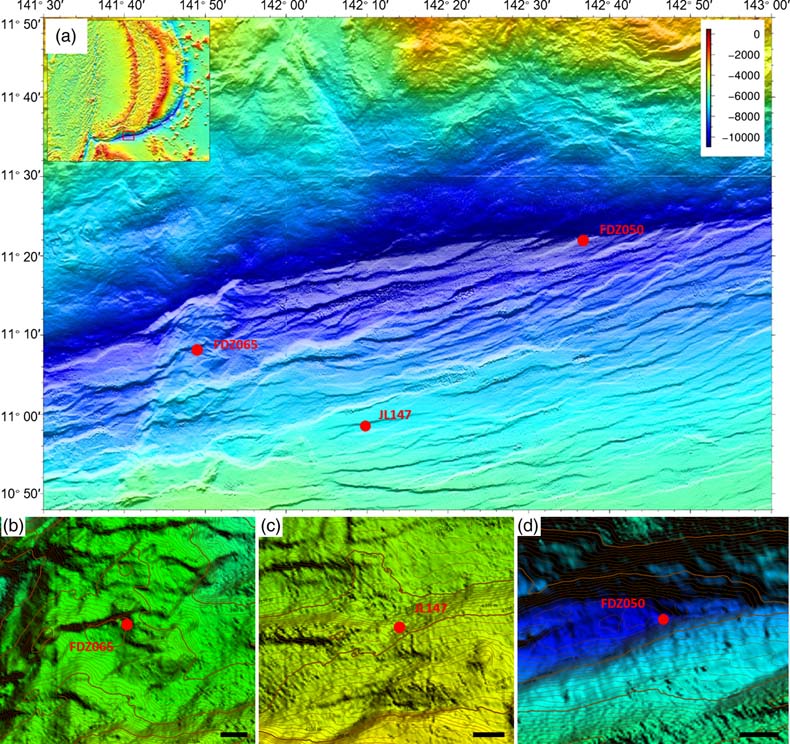
Figure 1 (a) A bathymetric shaded relief map of the study area displaying the location of the discovered carbonate sediments (red dots) on the incoming Pacific plate of the Mariana Trench. The map was constructed using multi-beam data obtained during several visits to the area by the R/V Tansuoyihao. (b–d) Enlarged bathymetric maps show that the sites of carbonate sediments are closely associated with bending-related fault zones.
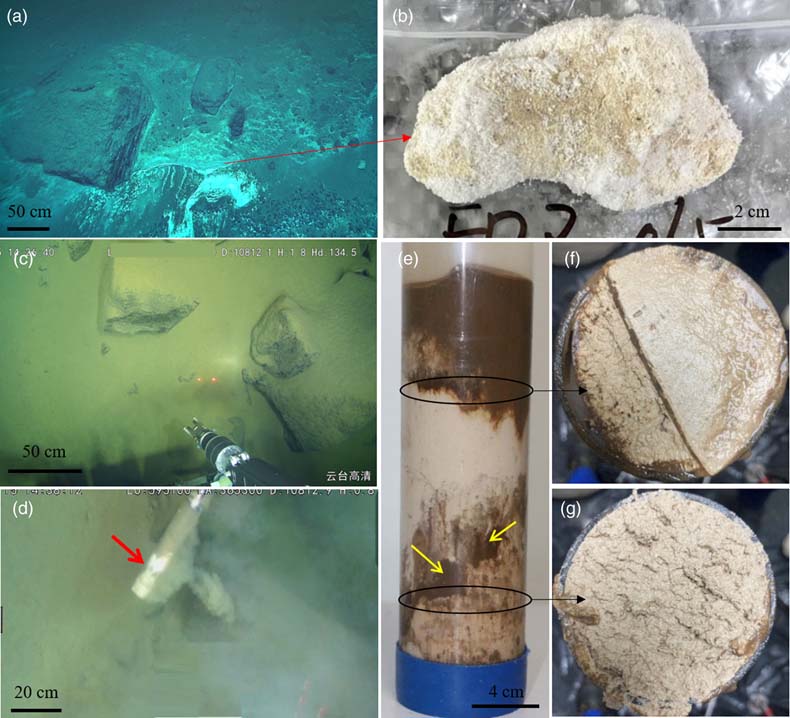
Figure 2 Carbonate sediments in the Challenger Deep of the MT. (a) Outcrop of carbonate deposits at site FDZ065. (b) Carbonate specimen from site FDZ065. (c) Topographic feature showing the discovery of carbonate deposits at site FDZ050. (d) White materials marked by red arrow are carbonate sediments at site FDZ050. (e) Push-core sediments from site FDZ050. Note: the presence of deep sea clay around the lower part (indicated by yellow arrows) is a result of sampling artifacts that occurred during the insertion of the push-core. This is verified by the cross section of the push-core (f and g). The inner of the push-core is pure white without clay (f and g). Only the core samples were used for analysis in this study.

Figure 3 Photomicrographs of carbonate sediments from the studied samples. (a) Buccinosphaera invaginata, First Appearance Datum (FAD): 0.34 Ma, 2 cm depth at site FDZ050. (b) Paragloborotalia siakensis, age: lower Oligocene–upper Miocene, 8 cm depth at FDZ050. (c) Cyclicargolithus floridanus. age: Paleogene 11.85 Ma, 8 cm depth at FDZ050. (d) Discoaster exilis, age: 17.39–10.49 Ma, 8 cm of FDZ050. (e) Calocycletta mizutamiensis, age: early mid-Miocene, 8 cm depth at FDZ050. (f) Calocycletta costata, age: 17.6–13.44 Ma, 21 cm depth at FDZ050. (g) Planktonic foraminifera Globoturborotalita euapertura, age: Oligocene–early Miocene, FDZ065. (h) Planktonic foraminifera Dentoglobigerina globularis, age: Oligocene–early Miocene, FDZ065.
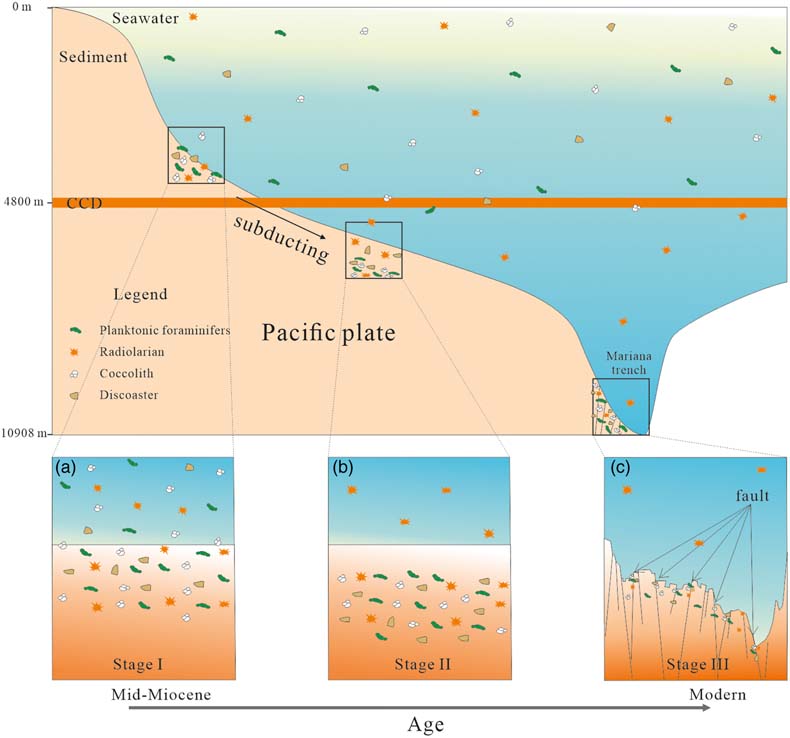
Figure 4 Conceptual diagram depicting the potential genesis of carbonate sediments in the Challenger Deep of the MT. (a) Stage I: carbonate was rapidly deposited and buried in the seafloor above the CCD during the mid-Miocene. (b) Stage II: the Pacific plate subduction carried these carbonate sediments from the site of sedimentation to the Challenger Deep of the MT. (c) Stage III: carbonate sediments were exposed due to the subducting-related normal faults.






